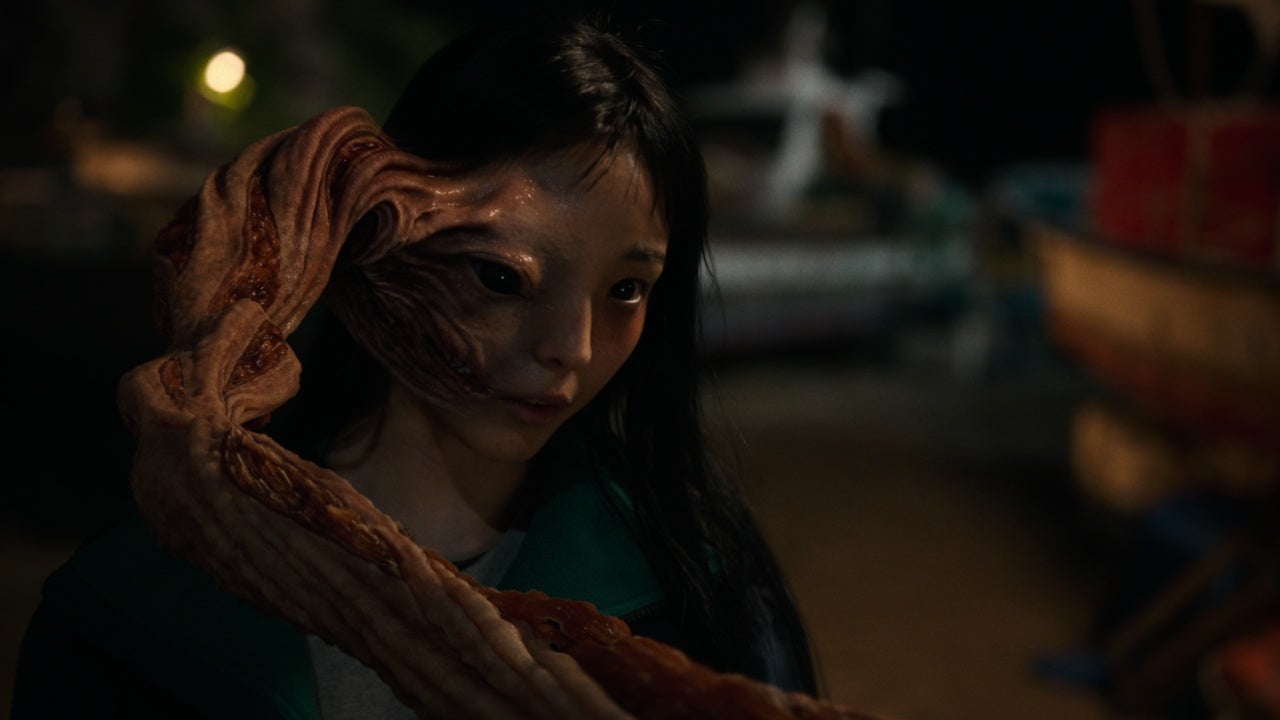Parasyte: The Grey is now streaming on Netflix
Hitoshi Iwaaki's Parasyte is best known for two things: Its head-morphing monsters and its two protagonists, ordinary high schooler Shinichi Izumi and his parasite Migi. Rather than try to replicate the tale of a teenage host and the alien that becomes his right hand, the new South Korean-set, live-action spin-off Parasyte: The Grey, goes for a wholly new cast and an original story.
Under Train to Busan director Yeon Sang-ho, our new protagonist is Jeong Su-in (Jeon So-nee), a 20something grocery store worker with a troubled past. When she is attacked and nearly killed on the way home from work, a parasite enters her body and heals her wounds. From that point, the parasite turns up as a sort of alternate personality; in a nod to the obvious Dr. Jekyll and Mr. Hyde parallels, Su-in comes to call it "Heidi.”
It's a smart adaptive choice in a series full of them, creating something distinct rather than staying rigidly faithful. And in a practical sense, Heidi avoids the technical complexity of an omnipresent creature like Migi, which only occasionally looks convincing in the two live-action Parasyte films from Godzilla: Minus One director Takashi Yamazaki. When Heidi’s in control, she might sprout a full tentacle from half of Su-in's face. More often, she announces her presence through a blackened eyeball, a pitched-down voice, and a blank expression.
Which isn’t to say the series skimps on depicting Iwaaki’s signature creations, which appear consistently throughout Parayste: The Grey in all their disgusting glory (and with far more frequency than the monsters in Hellbound, Yeon’s other Netflix series). Unlike Shinichi and Migi or Su-in and Heidi, other parasites retain only the appearance of their human hosts in order to blend into society. When it’s time to feed or defend themselves, they shift into gruesome new shapes, from flailing tentacle-blades to mangled meat-flowers. The realization of these monsters is truly impressive – amorphous and emphatically inhuman.
Parasyte: The Grey wastes little time laying out its own ideas – in the first of its lightning-paced episodes, the story skips forward a few months to jump right into how the emergence of the parasites is already beginning to reshape society. Suppressed smartphone footage of the creatures leads the South Korean government to assemble Team Grey, a militarized force that uses a captive parasite as a “hunting dog” to track down its kin. Meanwhile, the parasites have banded together under the guise of a Christian church group, complete with a grisly food pantry for its congregation. These developments shrewdly acclimate Parasyte to its new geographical setting: Team Grey’s efforts to control the media evokes South Korea’s own history with censorship, and the presence of a villainous church comments on the spread of Christianity in the country. It’s a sign of Yeon retrofitting the material to fit his personal pet themes, too. Organized religion is also at the core of Hellbound, and together with Train to Busan, all three projects reflect the director’s fascination with how the masses react when the world suddenly changes before their eyes.
But pushing these elements to the forefront through such quick pacing leaves little room to explore characters or even allow them to discover things organically. More than once, the principals find themselves at an all-hands meeting meant to hastily bring both them and the audience up to speed about the parasites: how they shapeshift, whether they can reproduce, how they recognize one another, and more are hastily laid out all at once. Heidi materializes as a fully alternate personality, dispensing with any scenes of Su-in getting used to her new powers, but as a consequence, we never get to know much about our rather reserved protagonist.
Initially, the separation between host and parasite feels like a clever obstacle – in contrast to the manga, Heidi and Su-in can’t directly converse with one another. But in practice, Su-in is left without much of a sounding board for her predicament, and Heidi has little space to explore the sociological angle about parasites integrating with society. By the time Su-in finally gets to speak her mind in Episode 4, the season is nearly over.
The supporting cast, which includes allies for Su-in like cowardly gangster Seol Kang-woo (Koo Kyo-hwan) and kindly detective Kim Cheol-min (Kwon Hae-hyo), leave more of an impression, but that’s more down to the actors’ performances than what’s on the page. Team Grey leader Choi Jun-kyung (Lee Jung-hyun) at least strikes a forceful, intimidating figure, with her omnipresent black gloves and an asymmetrical haircut that hides a wound from an up-close and deeply personal encounter with a parasite.
Parasyte: The Grey mainly gets by on its action and suspense, and it's no slouch in either regard. The conflict between Team Grey and the church pays dividends, setting up a labyrinth of schemes and betrayals that build on the idea of how sentient creatures, whether human or parasite, are far from monolithic in their aims. Yeon continues the action-oriented approach to horror he established in Train to Busan, with lots of shotguns toted by fully armored strike teams. Even humans like Kang-woo see their share of combat, like an elaborate chase sequence involving a van full of gangsters and a stolen motorcycle.
The camerawork in these scenes (and even in the opening credits) can feel a bit overdone. It's tough to deny the sense of danger and speed that it lends the parasites, but all that whooshing around is almost certainly an imperfect compromise meant to paper over any CGI deficiencies, too. Iwaaki’s manga has influenced decades of horror and sci-fi – perhaps most notably Resident Evil 4 – and Parasyte: The Grey is a persuasive reminder of why. The series has its shortcomings, but it’s faithful where it matters most: in reasserting the enduring power of a great monster.









